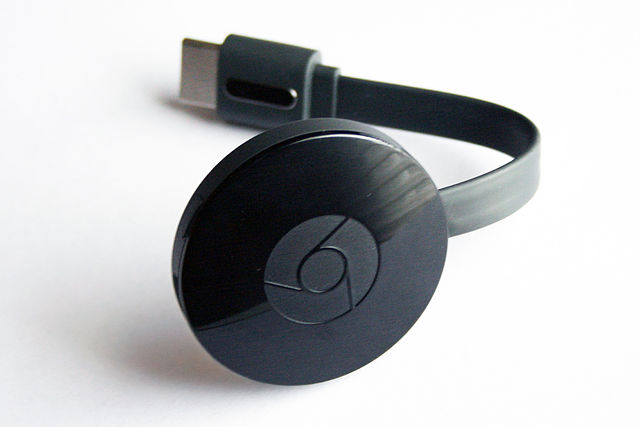It’s all about using your Big TV to gather Big Data.
- It’s cheap – The Roku retails for $49.99 at its lowest price point, and Apple TV retails for $99.00. If nothing else, the Chromecast beats the competition’s price point. (Note 9/23/2016: Chromecast — now in its 2nd generation — has seen its price dropped significantly since we posted this article: you can now get it for about $35 at many web-based retail sites).
- It works anywhere, needing only a wireless connection for streaming and interfaces with any Bluetooth device running on Android, which means most phones. It plugs into the HDMI port of any TV. This lets users bring their favorite TV providers into any living room.
- It brings the web anywhere – Chromecast launches from inside a Chrome browser. This lets users bring a web browser directly to any TV.
- All the apps are there – custom apps for Netflix and the other major streaming services are native to Chromecast.
- Chromecast supports all Android devices – any such device that has a Bluetooth capability can be used as a remote for Chromecast enabled TVs.
- Screen Mirroring – This much requested feature is a standard part of Chromecast, allowing the use of Android apps and streams directly into the Chromecast-equipped TV.
- Simple – Reports are that Chromecast is exceedingly simple to use – all that you need to do is to simply insert the Chromecast dongle into your TVs HDMI port, log into Google and your preferred services (Netflix, etc) and you’re ready to go.
So why is Google even bothering with this?
 Chromecast is but one of many similar devices – PC game distributor Steam has just announced development of its own proprietary device called Steambox that will stream movies and music as well as allow for video game play. Panasonic already has a streaming device, joining the Roku and Apple TV in the fray.
Chromecast is but one of many similar devices – PC game distributor Steam has just announced development of its own proprietary device called Steambox that will stream movies and music as well as allow for video game play. Panasonic already has a streaming device, joining the Roku and Apple TV in the fray.
Why should Google join the streaming video party? It’s this writer’s view that it’s all about the data. Consider that a user of the device will need a Google account to make use of the service. Consider also that each and every action that a Chromecast user takes online will therefore be tracked. This includes email content, browsing history, viewing habits, purchases – everything. (Note: it’s possible for users to put Chromecast into “incognito” mode but this means changing the default setting — a relatively obscure procedure it’s likely that many users — especially of the newbie variety — will not elect to perform).
It is this rich data that Google wants to sell to advertisers. By using the full spectrum of user activity to sell targeted advertising against, Google can offer advertising opportunities that directly match the needs and interests of that user, in a recommendation model similar to how Amazon conducts its amazing data-driven marketing. It’s all about using your Big TV to gather Big Data.
So Chromecast’s cool functionality — and the device’s attractively low price — are simply bait on the lure. What Google wants to do is to make us — the users — bite, whereafter it will reel in our data and sell ads against the data footprints we leave behind.
- 10 Mistakes to Avoid When Using QR Codes for Marketing - September 20, 2023
- Kevin Lee on How AI Changes the SEO Landscape - August 31, 2023
- The Power of Compound Marketing: Kevin Lee Presents @ 1MediaWorld 2023 Global Conference - March 7, 2023

